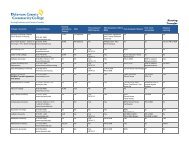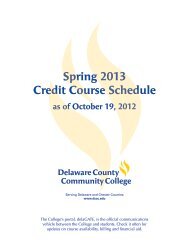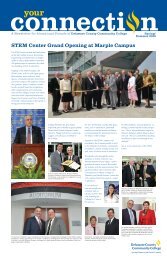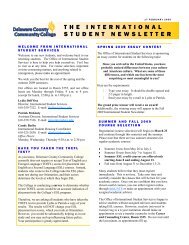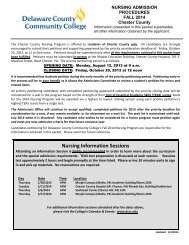2010 Catalog - Delaware County Community College
2010 Catalog - Delaware County Community College
2010 Catalog - Delaware County Community College
You also want an ePaper? Increase the reach of your titles
YUMPU automatically turns print PDFs into web optimized ePapers that Google loves.
86 COURSE DESCRIPTIONS<br />
ART 130<br />
Drawing I<br />
This course is an introductory level foundation course in<br />
drawing. A variety of media and subject matter including<br />
still life will be a focus in this course. Demonstration,<br />
discussion and formal critiques will augment studio work.<br />
Upon successful completion of this course students<br />
should be able to:<br />
• Demonstrate ability to draw utilizing perceptual means<br />
incorporating the basic properties of line, value, scale,<br />
proportion, figure-ground relationship and texture.<br />
• Demonstrate the ability to activate the concept of the<br />
picture plane.<br />
• Produce cohesive composition.<br />
• Diagram perspective.<br />
• Create the illusion of three-dimensional forms and<br />
space on a two-dimensional plane.<br />
• Integrate critical thinking skills through completed<br />
artworks and formal critiques.<br />
Prerequisite: None<br />
May be repeated with Dept approval<br />
3 Credits 2 Weekly Lecture Hours<br />
2 Weekly Laboratory Hours<br />
ART 140<br />
Painting I<br />
This is a foundation level studio course in acrylic painting<br />
with instruction of the use of brush and palette knife. Still<br />
life subject matter will be the predominant source of<br />
visual imagery in this course. Demonstration, discussion<br />
and formal critiques will augment studio work.<br />
Upon successful completion of this course, students<br />
should be able to:<br />
• Prepare the materials for the process of painting.<br />
• Demonstrate knowledge and understanding of the<br />
12-hue color wheel.<br />
• Produce cohesive composition.<br />
• Demonstrate the ability to analyze how light creates<br />
form with the interplay of hue, value and chroma.<br />
• Create the illusion of three-dimensional forms and<br />
space on a two-dimensional plane.<br />
• Integrate critical thinking skills through completed<br />
artworks and critiques.<br />
Prereq. ART 130<br />
3 Credits 2 Weekly Lecture Hours<br />
2 Weekly Laboratory Hours<br />
ART 141 Painting II Special Studies<br />
This course will continue to stress general foundation<br />
painting skills in the acrylic and or mixed media. Subject<br />
matter will expand from the still-life to more conceptual<br />
based integration of various imagery. Demonstration<br />
discussion and formal critiques will augment studio work.<br />
Upon successful completion of this course, students<br />
should be able to:<br />
• Prepare the materials for the process of painting<br />
• Demonstrate knowledge and understanding of the 12-<br />
hue color wheel<br />
• Demonstrate the ability to activate the concept of the<br />
picture plane using traditional and non-traditional means.<br />
• Produce cohesive composition.<br />
• Demonstrate the ability to analyze how light creates<br />
form with the interplay of hue, value and chroma.<br />
• Manipulate the illusion of three-dimensional forms<br />
and space.<br />
• Integrate critical thinking skills through completed<br />
artworks and critiques.<br />
Prereq. ART 140<br />
3 Credits 3 Weekly Lecture Hours<br />
ART 143<br />
Life Drawing and Painting<br />
This course will emphasize life drawing and painting<br />
from the nude and draped model considering both<br />
objective and non-objective responses. Drawing with a<br />
variety of wet and dry media will be stressed in the<br />
course with a progression into acrylic painting on canvas.<br />
Demonstration, discussion and formal critiques will<br />
augment studio work.<br />
Upon successful completion of this course, students<br />
should be able to:<br />
• Demonstrate the ability to draw the human figure<br />
utilizing perceptual means incorporating bold, gestural<br />
and quick mark-making skills.<br />
• Demonstrate the ability to draw and paint the human<br />
figure utilizing perceptual means within a sustained<br />
pose incorporating the basic properties of line, value,<br />
scale and proportion, figure-ground relationship, texture<br />
and color.<br />
• Demonstrate the ability to draw and paint the human<br />
figure incorporating basic rules of anatomy and art<br />
historical connections.<br />
• Demonstrate the ability to activate the concept of the<br />
picture plane.<br />
• Produce cohesive composition.<br />
• Integrate critical thinking skills through completed<br />
artworks and formal critiques.<br />
Prereq. ART 140<br />
3 Credits 2 Weekly Lecture Hours<br />
2 Weekly Laboratory Hours<br />
ART 145<br />
Watercolor Painting<br />
This course is an introduction to the basic tools and<br />
techniques of the watercolor painter. Emphasis is placed<br />
upon transparent watercolor within the Western tradition in<br />
still life, landscape, figurative and non-objective subject<br />
matter. Demonstration, discussion and formal critiques will<br />
augment studio work.<br />
Upon successful completion of this course, students<br />
should be able to:<br />
• Prepare the materials for the process of painting.<br />
• Demonstrate the knowledge and understanding of the<br />
12-hue color wheel.<br />
• Demonstrate the ability to activate the concept of the<br />
picture plane.<br />
• Produce cohesive composition.<br />
• Apply the wash, glazing, variegated wash, wet into wet,<br />
lifting, scraping, resist, drops and splatter, and dry brush<br />
techniques within a watercolor painting.<br />
• Integrate critical thinking skills through complete<br />
artworks and formal critiques.<br />
3 Credits 2 Weekly Lecture Hours<br />
2 Weekly Laboratory Hours<br />
ART 160<br />
Black and White Photography I<br />
This course is designed to introduce students to the<br />
basics of picture taking and picture making. Topics<br />
include use of 35mm camera and lens, film processing,<br />
printing and photochemistry. Two-hour photolabs will<br />
provide practical darkroom experience.<br />
Upon successful completion of this course, students<br />
should be able to:<br />
• Identify and apply camera handling and cleaning<br />
techniques.<br />
• Define and describe characteristics of black and white<br />
films and print papers.<br />
• Calculate correct photographic exposures under a variety<br />
of lighting conditions.<br />
• Describe and apply basic principles of photographic<br />
composition.<br />
• Apply principles governing use of contrast filters.<br />
• Describe and apply the technical and aesthetic criteria by<br />
which photographs are evaluated.<br />
• Prepare a portfolio of black and white enlargement prints<br />
that exhibit effective focus, depth of field, contrast,<br />
cropping and display.<br />
Need 35mm camera with adjustable settings<br />
3 Credits 3 Weekly Lecture Hours<br />
ART 161 Black and White<br />
Photography II<br />
This course is a continuation of Black and White Photography<br />
I. Students learn more about the art of photography<br />
by exploring advanced approaches to composition,<br />
lighting and printing. Using photochemistry and setting<br />
up a home darkroom are among the topics presented.<br />
Upon successful completion of the course, students<br />
should be able to:<br />
• Use a light meter and gray card to calculate scene<br />
brightness ratios.<br />
• Adjust film-speed ratings to compensate for camera or<br />
lighting exposure factors.<br />
• Prepare commonly used photochemicals and describe<br />
their contents.<br />
• Print "problem" negatives by altering local and overall<br />
density and contrast in the print.<br />
• Adjust film development times to compensate for<br />
lighting conditions.<br />
• Produce a portfolio of fully toned black and white prints<br />
that exhibit strong technical and aesthetic values.<br />
Prereq. ART 160 or instructor's permission<br />
3 Credits 3 Weekly Lecture Hours<br />
ART 162 Black and White Photography III<br />
This is a lab-intensive course for students with one year<br />
of previous course work in photography. The use of<br />
photography as an expressive tool is approached by study<br />
and application of advanced methods of working with<br />
camera and processing film and prints with specialized<br />
photochemistry. Student learn to select print papers that<br />
enhance image quality. The limits of the 35mm negative<br />
format are explored.<br />
Upon successful completion of this course, students<br />
should be able to:<br />
• Previsualize subject matter for black and white photographs.<br />
• Determine personal film speed.<br />
• Adjust film processing to compensate for scene brightness.<br />
• Produce their own gray scales and meter cards.<br />
• Control the tonal ranges in prints from negatives made<br />
under a variety of lighting conditions.<br />
• Prepare a portfolio of exhibition quality, archivally<br />
matted prints.<br />
Prereq. ART 161 or equiv.<br />
3 Credits 3 Weekly Lecture Hours<br />
ART 166<br />
Black and White Digital<br />
Negative<br />
This course is a continuation of Black and White<br />
Photography, which incorporates the use of digital<br />
darkroom techniques. Students will learn the art of<br />
conventional printing using enlarged digital negatives.<br />
Students will have the opportunity to learn the advanced<br />
changes offered to them through the use of digital<br />
photography, bridging the technological gap between<br />
traditional methods and rapidly changing digital methods<br />
in photography. The course is not intended to abandon<br />
traditional methods of photography, but to incorporate the<br />
technology. This course will not involve the use of digital<br />
cameras. The course will use computers to enlarge black<br />
and white negatives for contact printing.<br />
Upon successful completion of the course, the student<br />
should be able to:<br />
• Integrate knowledge of conventional analog into digital<br />
photography techniques.<br />
• Monitor calibration for digital negative production.<br />
• Apply the various methods of scanning for digital<br />
negative resolution.<br />
• Practice with the digital negatives to enhance images for<br />
fine printing (dodging, burning, sharpening, masking,<br />
and contrast controls).<br />
• Use storage and transfer media for file compression.<br />
DELAWARE COUNTY COMMUNITY COLLEGE




